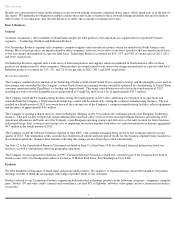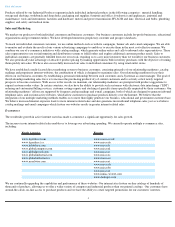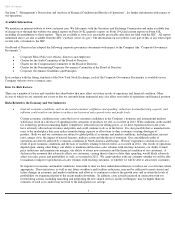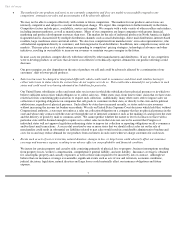CompUSA 2012 Annual Report Download - page 14
Download and view the complete annual report
Please find page 14 of the 2012 CompUSA annual report below. You can navigate through the pages in the report by either clicking on the pages listed below, or by using the keyword search tool below to find specific information within the annual report.
We require significant levels of capital in our business to finance accounts receivable and inventory. We maintain credit facilities
in the United States to finance increases in our working capital if available cash is insufficient. The amount of credit available to us
at any point in time may be adversely affected by the quality or value of the assets collateralizing these credit lines. In addition, in
recent years global financial markets have experienced diminished liquidity and lending constraints. Our ability to obtain future
and/or increased financing to satisfy our requirements as our business expands could be adversely affected by economic and market
conditions, credit availability and lender perception of our Company and industry . However, we currently have no reason to
believe that we will not be able to renew or replace our facilities when they reach maturity.
Our United States revolving credit agreement contains covenants restricting or limiting our ability to, among other things:
• incur additional debt
• create or permit liens on assets
• make capital expenditures or investments
• pay dividends
If we fail to comply with the covenants and other requirements set forth in the credit agreement, we would be in default and would
need to negotiate a waiver agreement with the lenders. Failure to agree on such a waiver could result in the lenders terminating the
credit agreement and demanding repayment of any outstanding borrowings, which could adversely affect our cash position and
adversely affect the availability of financing to us, which could materially impact our operations.
As of December 31, 2012, we had approximately 5,300 employees, 1,500 of which are located in Europe and Asia. We have
workers’ councils representing the employees of our France, Germany, and Netherlands operations, and trade unions representing
our employees in Italy and Sweden and elected employee representatives for our employees in the United Kingdom and Spain.
Most of these European employees are employed in countries in which employment laws provide greater bargaining or other rights
to employees than the laws of the U.S. Such employment rights require us to work collaboratively with the legal representatives of
the employees to effect any changes to labor arrangements. For example, most of our employees in Europe are represented by
unions or workers’ councils that must approve certain changes in conditions of employment, including salaries and benefits and
staff changes, and may impede efforts to restructure our workforce. The establishment of our shared services center in Hungary
regarding related reductions in force is subject to discussion with and approval of certain of the workers councils. We believe that
we have a generally good relationship with these councils and unions. We have entered into consultation processes under local laws
at our Germany, France, Netherlands and Italy locations for, among other things, restructuring our operations and effecting
reductions in force in connection with implementing our shared services center in Hungary. Although we believe that we have a
good working relationship with our employees, a strike, work stoppage or slowdown by our employees or significant dispute with
our employees could result in a significant disruption of our operations or higher ongoing labor costs.
We currently have 41 retail stores operating in North America at December 31, 2012. The Company needs to effectively manage
its cost structure including the additional inventory needs, retail point of sales IT systems, retail personnel and leased
facilities. Future growth in retail will also be dependent on the ability to attract customers and build brand loyalty. The retail
computer and consumer electronics business is highly competitive and has narrow gross margins. If we fail to manage our growth
and cost structure while maintaining high levels of service and meeting competitive pressures adequately, our business plan may
not be achieved and may lead to reduced profitability .
Table of Contents
• We depend on bank credit facilities to address our working capital and cash flow needs from time to time, and if we are unable to
renew or replace these facilities, or borrowing capacity were to be reduced our liquidity and capital resources may be adversely
affected.
•
If we fail to observe certain restrictions and covenants under our credit facilities the lenders could refuse to waive such default,
terminate the credit facility and demand immediate repayment, which would adversely affect our cash position and materially
adversely affect our operations.
• Our European employees are represented by unions or workers’ councils or are employed subject to local laws that are less
favorable to employers than the laws of the U.S.
• We operate retail stores in North America and we must effectively manage our cost structure, such as inventory needs, point of
sales systems, personnel and lease expense.
12
























